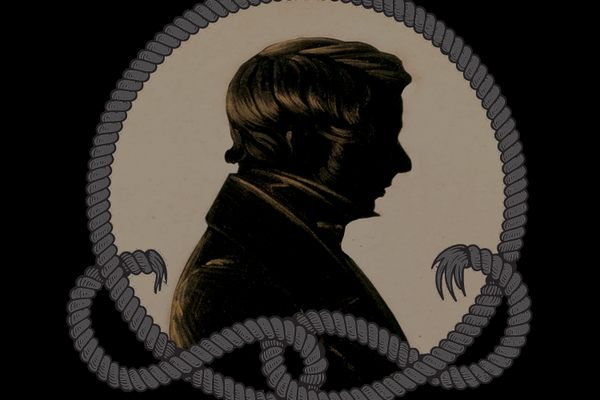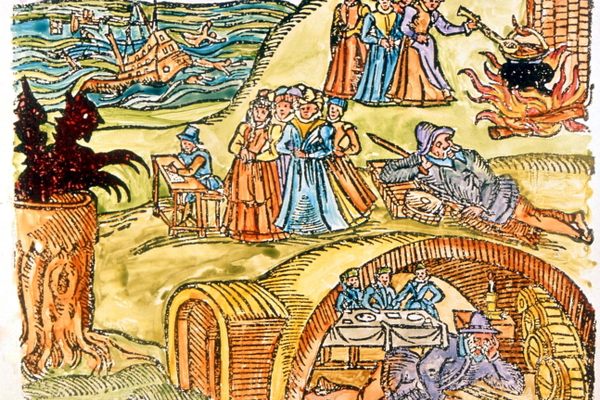An Invitation to a Hanging
Photograph taken before the 1910 execution of John D. Lee, who sits beside his future coffin, for his part in the Mountain Meadows massacre (via Salt Lake Tribune)
When executions in the United States changed from public spectacles to private affairs in the 19th century, there was a curious trend of formal invitations to the guests. These invitations to hangings and other forms of execution could be as ceremonial as an invite to a wedding, sometimes handwritten, other times specially engraved.
Invitation to a hanging from 1892 in the National Cowboy & Western Heritage Museum (photograph by the author)
For example, here’s an 1892 invitation to the execution of one John Burns in Missoula, Montana, that is on display in the National Cowboy & Western Heritage Museum in Oklahoma City. The fonts are varying and elaborate (keep in mind this all had to be set and printed by hand) and it has a somber dark border, despite its polite request of your presence making a macabre affair seem more like an afternoon party.
Burns was a jewel thief who attempted to shoot his partner-in-crime so he could have all the reward, but ended up killing an innocent young volunteer firefighter name Maurice Higgins instead. Curiously, his execution was followed with a report in The Missoulian that “The Body of Burns is Not in the Grave,” and instead had been embalmed and put on display, although this wasn’t confirmed, and was furthermore chased by rumors of his skin being made into shoes.
The first execution invitation for George Smiley (via truewest.ning.com)
The invitations to jurors, public figures, and law enforcement officers were often a requirement for sheriffs in the Old West, but how they carried them out showed their own individual flair, for better or worse. Perhaps none had such a frivolity with his execution invitations as F. J. Wattron in Arizona’s Navajo County. The initial invitation for the hanging of George Smiley was printed on gold-lined paper that read:
You are hereby cordially invited to attend the hanging of one George Smiley, Murderer. His soul will be swung into eternity on Dec. 8, 1899, at 2 o’clock, p.m., sharp. Latest improved methods in the art of scientific strangulation will be employed and everything possible will be done to make the proceedings cheerful and the execution a success.
According to an article by Kathy Weiser for Legends of America, the invitation was acquired by a journalist and ended up being reprinted across the country and even in Europe, making it all the way to Berlin. President McKinley himself was apparently none too pleased with Wattron’s blithe invitation, and as a punishment ordered a 30 day stay on the execution, which of course required the printing of a whole other invitation. This one Wattron apparently tried for a bit more restraint, keeping to a black-edged paper instead of the flashy gold, but you can practically see the sheriff’s eyes rolling behind the new text: “With feelings of profound sorrow and regret, I hereby invite you to attend and witness the private, decent and humane execution of a human being; name, George Smiley, crime, murder.” This was followed by a listing of the new date and time, as well as an urging to “deport yourself in a respectful manner.”
Invitation to the 1875 execution of Tiburcio Vasquez in San Jose, California (via California Historical Society)
Usually, droll Arizona sheriffs aside, the invitations looked like this, although the death of “bandido” Tiburcio Vásquez was a particularly hot ticket (but note the “not transferable” for any party that was considering scalping their invite). Vásquez, today something of a folkloric hero, was a dashing criminal who was as fond of dancing and courting the ladies as he was of robbery, although it was in the end one of his lovers who turned him over to the authorities. Still, it’s still debatable whether he was responsible for killing anyone, despite the bystanders who perished at one robbery, and he remains a California icon with even a school controversially taking up his name earlier this year.
Invitation to the 1902 hanging of Lum You (via University of Washington Press)
Often for these high profile executions, hundreds of invitations would be sent, which is why the ones that survive tend to be from infamous cases like that of Lum You. The Chinese laborer, and popular local figure in Pacific County, Washington, had gotten into some previous trouble attacking a man with an ax following a dispute. However, it was in retaliation that he shot Oscar Bloom after Bloom had assaulted and robbed You. The public was sympathetic to the man-about-town, but the judge was not and sentenced him to death by hanging. Reportedly about 500 invitations went out for the 1902 execution (including, as was custom, to some boys to show them the danger of crime). His last words were recorded as: “Kill me good.”
Invitation to the hanging of Dr. Frank Vincent in Fresno County (via Historical Perspectives)
Invitations to executions didn’t end with the quelling of the outlaw spirit of the Old West. Those stately, almost dainty, invitations continued well into the mid-20th century (here’s the rather jovial ADMIT ONE for the Lindberg baby killer Bruno Richard Hauptmann). In a way, despite the grisly event that was central to each of these little cards, they were a small move away from the brutal spectacles that executions of previous centuries tended to be (and have not, it should be noted, entirely stopped being), where the extreme refinement of the invitations seemed to be trying to take some of the barbarism out of death.
Invitation to a 1903 execution in Oregon, note the crime listed at the bottom (via Curtis Irish)
Invitation to the 1888 execution of Oscar F. Beckwith, the “Austerlitz Cannibal” (via Bat Country Books, LLC)
Invitation to the 1888 execution of Charles Johnson (via trutv.com)
Morbid Mondays highlight macabre stories from around the world and through time, indulging in our morbid curiosity for stories from history’s darkest corners. Read more Morbid Mondays>
Join us on Twitter and follow our #morbidmonday hashtag, for new odd and macabre themes: Atlas Obscura on Twitter







Follow us on Twitter to get the latest on the world's hidden wonders.
Like us on Facebook to get the latest on the world's hidden wonders.
Follow us on Twitter Like us on Facebook